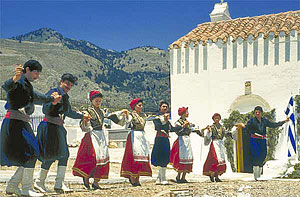User:Deliaradu0821/sandbox/Karagouna
|
This page is a sandbox of user:Deliaradu0821. It serves as a testing spot and page development space for the user and is not an encyclopedia article.
|
Karagouna is a greek dance founded in plain of Thessaly in Middle Greece. It is a traditional wedding dance. As for the costume, it is said that there are three or four variants depending on the region. According to local traditions, it used to be a dance for women only but nowdays is performed by both men and women.

Cite error: There are <ref> tags on this page without content in them (see the help page).== Name and etymology ==
The name Karagouna is by black scarves that was weared by woman in central Greece,Thessaly.
Over the years many arguments have been posed, concerning the origin of the name "Karagouna".One of them claims that it derives from the word kara and gouna (black fur) [[1]] while another one says that it comes from the prefix kara and the word Yunan, meaning black native Greek [4].
More versions exist, like the one that says that it originally came from the words kara and kouna (due to the dancers' habit to move –“kouna” their heads while dancing) or that it is borrowed by the people living there under the name Karagounithes, who are farmers and shepherds in the Thessaly plains
Composition and rhythm
There are two basic forms of the" Kragouna dance". The first formation is the one which the dance usually begins with, and its name is Svarniara. The Svarniara movement is a circular one heading forwards, accompanied by a specific song, "Karagouna goes to vrisi" (spring). The song is a hymn to the female garment. The dance follows the same steps as the syrto dance, only this time the steps are heavier and slower. The "Svarniara" movement is performed several times by the dancers and then it is followed by the "Karagouna" dance alongside with the song" Ante Karagouna _Gouna Karagouna".[1]
Dance Lyrics
Άιντε μωρή…γκού… …γκούνα Καραγκούνα, άιντε δεν σου πρέ… σου πρέπουν τα σεγκούνια, αμ’ πως ‘δα αμ’ πις ‘δα στο παραθύρι σ’ είδα, αμ’ πως ‘δα αμ’ πις ‘δα την προκοπή σου είδα. Άιντε θα πουλή… πουλήσω και την στάνη, άιντε να σου πά… σου πάρω ένα φουστάνι, αμ’ πως ‘δα αμ’ πις ‘δα στο παραθύρι σ’ είδα, αμ’ πως ‘δα αμ’ πις ‘δα την προκοπή σου είδα. Άιντε θα πουλή… πουλήσω την κατσίκα, άιντε να σου πά… σου πάρω σκουλαρίκια, αμ’ πως ‘δα αμ’ πις ‘δα στο παραθύρι σ’ είδα, αμ’ πως ‘δα αμ’ πις ‘δα την προκοπή σου είδα. Άιντε θα πουλή… πουλήσω και τα γίδια, άιντε να σου πά… σου πάρω και στολίδια, αμ’ πως ‘δα αμ’ πις ‘δα στο παραθύρι σ’ είδα, αμ’ πως ‘δα αμ’ πις ‘δα την προκοπή σου είδα. Άιντε πέρασε ένα καλοκαίρι, άιντε και δε μου δε μου ‘στειλες χαμπέρι,αμ’ πως ‘δα αμ’ πις ‘δα στο παραθύρι σ’ είδα, αμ’ πως ‘δα αμ’ πις ‘δα την προκοπή σου είδα..
Parts
The Karagouna dance consists of three (3) dancing patterns where the steps are different but they are equal in time and rythm. The music meter is 4/4 and 2/4 bagio and the held is done by the palm of the hand with the elbows bent. It is formed by three (3) parts of eight (8) steps and (2*12) Kalamatiano dance.
Variations
(place / time spread and differentiation)
Cultural significance
(symbolism, occasions)
In popular culture
(books, movies, tv series)
Criticism
Gallery
-
caption
-
caption
See also
References
<1.Δήμας Ηλίας, Ελληνικοί παραδοσιακοί χοροί, Αθήνα, 1990>
Bibliography
- Δήμας, Ηλίας. Ελληνικοί παραδοσιακοί χοροί. ΑΘΗΝΑ.
- Κοκκίνου, Γιάννης (1987). Ελληνικοί Χοροί. Thessaloniki: ΣΑΛΤΟ.
- ΡΑΦΤΗΣ, ΑΛΚΗΣ (1995). ΕΓΚΥΚΛΟΠΑΙΔΕΙΑ ΤΟΥ ΕΛΛΗΝΙΚΟΥ ΧΟΡΟΥ. Θέατρο Ελληνικών Χορών. ISBN 960-7204-11-5.
Further reading
- title.
- title.
External links
- ^ 2

